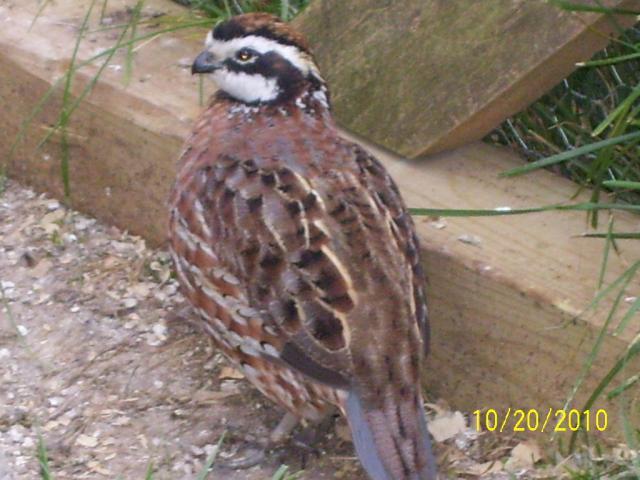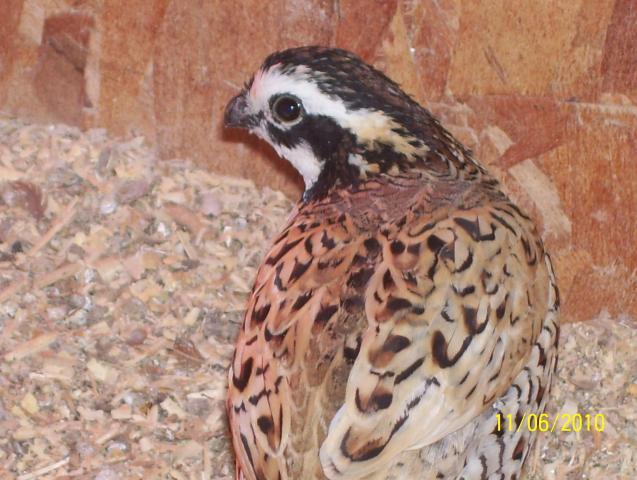

Bobwhite Quail are used for Hunting, Dog Training, Breeding, Meat, sometimes Eggs, and Fun!!
The males have mostly reddish, brown feathers with white, barred with black feathers, on their belly. The throat and a line around the eye are white, with a black line of feathers extending from the eye backwards to the throat. Full grown males can be about 10 inches long. Males that have yet to "pair up" with a hen will call the distinctive "Bob-Bob-White". After pairing up, they drop the first "Bob". The females colors are identical except for the white area around the eye and throat which is buff colored. This makes sexing the birds quite easy as the differences in head color are obvious. Full grown females quail are about the same size as the males. The eggs are pure white, and hatch in 23 to 24 days. My hens usually start laying at 6 months.
BREEDING
Bobwhites present no problems in captive rearing, and can be produced easily in small or large aviaries. Many producers house their breeders on wire, some as big as 10x10 and keep them in trios or pairs. You can choose to colony mate (several hens with two or three males), trios (one male with two hens) or in pairs.
Bobwhite hens begin laying in mid April and may lay all summer long. The eggs are pure white and are incubated for 21 days. You will probably have to use artificial incubation with this species, as many captive hens are mass producers of eggs are highly unlikely to go broody in a cage setting. Bobwhites are easy to keep and raise. They are often one of the first species of quail for the beginning quail breeder and many long-time breeders keep them around for the male's call. Like many other species of quail, they seem to do best on wire, but can be kept on the ground if the aviary is well-drained. During the Winter, birds that are not kept indoors such as a barn, should be grouped together so they can form natural coveys for warmth. I also recommend keeping dry straw or hay in the cage during the Winter. Bobwhites should be fed a good quality game bird ration of at least 18% protein during the non-breeding season to 20% during the laying period.
Brooding
Make sure you offer plenty of fresh feed and water. We feed our chicks Manna Pro Gamebird Starter on bucket covers for the first three weeks then we start adding adult food to the starter as well as using feed bowls. Pay close attention to the size of the feed crumbles during this time. It may be necessary to run the feed through a food processor to "powder" it before feeding it to the chicks. If the crumbles are too large a chick may develop an impacted craw. A "no-drown" waterier for chicks is essential as they easily become wet or drown in water dishes. Make sure the water and feed is not placed directly under the heat source and is changed out at least once daily. This prevents spoilage by poop and dirt and the water from getting too hot. In addition it forces the chicks to move around and exercise. When they reach adulthood, we switch to Gamebird Flight Conditioner Feed. Seed, dry greens, and grit is also given to the adults as treats.
BOB COLORS
Orange
Mexican Speckled
Silver
Smoky
White
TYPES OF QUAIL
Tennesee Red
Wisconsin Jumbo
Butler
Georgia Giant
PICS
Tennessee Red

Jumbo Bob Male

Mexican Speckled Male

Last edited:




